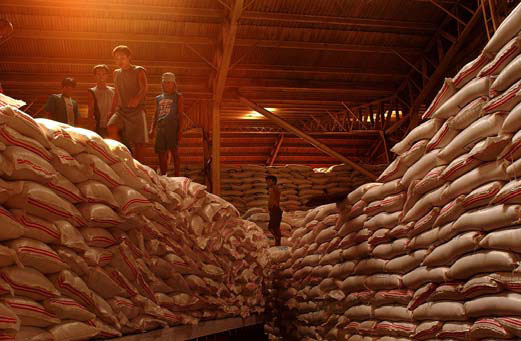Grain storage
 Rice storage facilities take many forms, depending on the grain quantity to be stored, the purpose of storage, and the location of the store. It is recommended, as storing rice for consumption, be stored in paddy form rather than milled rice because the husk provides some protection from insects and helps prevent quality deterioration. For storing brown rice, 20% less storage capacity will be needed.
Rice storage facilities take many forms, depending on the grain quantity to be stored, the purpose of storage, and the location of the store. It is recommended, as storing rice for consumption, be stored in paddy form rather than milled rice because the husk provides some protection from insects and helps prevent quality deterioration. For storing brown rice, 20% less storage capacity will be needed.
Requirements
A good storage system must
- prevent moisture from re-entering the grain after drying;
- provide protection from insects, rodents, and birds;
- have efficient space, and
- be easy to maintain and manage.
Rice grain is hygroscopic and, in open storage systems, grain moisture content will eventually equilibrate with the surrounding air. High relative humidity and high temperature contribute to high equilibrium or final moisture contents. In many tropical countries, equilibrium moisture content is above safe storage moisture levels.
Safe storage conditions for grain
Safe storage of rice for longer periods is possible if three conditions are met:
- Grain is maintained at moisture level of 14% or less and seed is stored at 12% moisture level or less.
- Grain is protected from insects, rodents, and birds.
- Grain is protected from rewetting by rain or imbibing moisture from the surrounding air.
The longer the grain needs to be stored, the lower the moisture content required. Grain and seed stored at moisture content above 14% may experience growth of mold, rapid loss of viability, and a reduction in eating quality. The ‘safe’ moisture content required for different storage periods is seen in the table.
| Storage | Required moisture content for safe storage |
Potential problems if requirement not met |
| 2 to 3 weeks | 14–18 % | Molds, discoloration, respiration loss |
| 8 to 12 months | 12–13 % | Insect damage |
| more than 1 year | 9% or less | Loss of viability |
A rule of thumb for seed is that the life of the seed will be halved for every 1% increase in moisture content or a 5oC increase in storage temperature.
For more information:
Visit the Rice Knowledge Bank Web Site (http://www.knowledgebank.irri.org), email postharvest@irri.org; or call +63 2 580 5600







